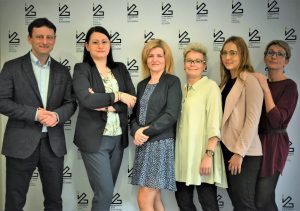By
Tomasz Wasilewski, Zofia Hordyjewicz-Baran, Magdalena Zarębska, Natalia Stanek, Ewa Zajszły-Turko, Magdalena Tomaka
Vineyard Estro, photo by Piotr Krysiak.
The growing consumer demand for environmentally conscious, sustainable, and beneficial products has led researchers around the world to look for smart strategies to reduce the negative impact on the environment, especially when it comes to industrial or agricultural waste. Among the natural various by-products commonly considered as waste, those obtained in the wine industry have attracted the attention of many companies, not only wineries.
Grapes, one of the most consumed fruits in the world, are rich in bioactive compounds, edible acids, dietary fiber, etc. Therefore, grapefruits are the subject of intense research for their potential beneficial effects on human health. The red-purple pigmentation of grapes is related to the presence of chemical compounds – anthocyanins, a common group of chemicals that give color to flowers and fruits. These red to blue colored compounds are powerful antioxidants. Even low concentrations of anthocyanins can reduce the amount of UVB radiation affecting the epidermis, demonstrating the benefits of anthocyanins in preventing UV-induced skin damage. Anthocyanins are also used as natural dyes.
Many consumers drink wine for its potential health benefits, but the waste generated during its production can also be a good source of bioactive compounds.
In the last decade, a significant increase in interest in vine cultivation, the establishment of vineyards for commercial and enotourism purposes, and wine production has been observed in Poland.
According to the data of the National Agricultural Support Centre (KOWR), the trend from 2009 to 2022 indicates a substantial increase in the number of registered producers, from 21 to 380, and it is expected to continue growing each year. The increase in vine cultivation is integrally related to the increase in the amount of waste generated. It is assumed that one ton of harvested and processed grapes generates on average 130 kg of pomace, 60 kg of lees and 30 kg of stalks.

Scientists from the Łukasiewicz Research Network – Institute of Heavy Organic Synthesis “Blachownia”: dr Zofia Hordyjewicz-Baran, dr Natalia Stanek, Magdalena Zarębska, Ewa Zajszły-Turko, Magdalena Tomaka, together with prof. Tomasz Wasilewski from cosmetics company CosMedChem, analyzed the possibility of using vineyard waste to produce full-value cosmetic raw materials.
The cosmetics industry is a rapidly developing field, which has resulted in increased demand for new ingredients, preferably of natural origin. Therefore, the use of waste materials from wine production as a source of phytochemicals in cosmetic preparations can contribute to the development of this industry, and consequently to environmental and economic sustainability.
The aim of the study was to isolate bioactive compounds from waste plant material, specifically red grape pomace from wine production. Regent, Rondo and Solaris grape varieties grown on the Estro Vineyard established in 2019 in the Opole region of Poland were selected for this study.
The researchers presented the results of their study on an innovative approach to cosmetics production. In traditional solutions, extracts are added during the main process of cosmetic mass production. In the proposed solution, the extraction process is one of the steps of producing cosmetics. In this approach, the extraction medium is a aqueous solution of compounds that are components of the cosmetic produced. The composition of the extraction medium is selected to obtain aggregates (micelles) in the bulk phase, giving the possibility of effective leaching of cosmetically valuable components from the plant material, in a similar way to micellar extraction. The proposed cosmetic manufacturing method includes a key step referred to as “loan chemical extraction” (LCE), described for the first time by authors and defined by “extraction using ingredients borrowed from the final product”.
In this study waste from wine production in the form of grape marc was processed into cosmetic components using Loan Chemical Extraction (LCE) developed by the researchers.
The obtained extracts were evaluated for the content of substances valuable from the cosmetological point of view. For this purpose, the composition of the extracts was characterized using a highly advanced liquid chromatography-tandem mass spectrometry (LC-MS/MS) technique and their antioxidant capacity was examined.
The results showed that the extracts based on waste grape pomace contained a number of bioactive compounds. These included polyphenols such as flavonols (quercetin, kaempferol), flavanols (catechins, epicatechins), anthocyanins (malvidin 3-O-glucoside, peonidin 3-O-glucoside, petunidin 3-O-glucoside) and stilbenes (resveratrol). The presence of organic acids (tartaric, citric, malic) was also demonstrated. The composition of the compounds showed antioxidant activity, so it can protect the skin from negative environmental influences.
The biological activity of the compounds derived from grape extracts favors their valorization as a source of bioactive phytochemicals for application in cosmetics and provides an effective and environmentally friendly alternative for the use of the resulting waste.
In accordance with the existing clear research trend related to improving the safety of washing cosmetics, an attempt was made to determine the possibility of preparing model shower gels based on obtained grape pomace extract. LCE was used as an effective and safe process to produce cosmetic components rich in biologically active compounds extracted from plant material.
Prototypes of natural washing cosmetics (shower gels) were developed and manufactured. Samples of manufactured model shower gels were evaluated for their basic functional parameters (e.g., foaming properties, rheological properties, color) and skin effects. It was observed that the addition of extracts had no significant effect on the parameters related to functionality (e.g., foaming properties, viscosity), while the obtained model products showed more benefits for the washed skin, caused less irritation and were less skin drying (in comparison with analogous shower gels not containing extracts). Additionally, the products had a naturally beautiful color in red shades, which was well perceived by consumers.
The study showed that grape pomace produced during wine production, although being mainly a waste material for winemakers, is a very valuable cosmetic raw material, and model products made on its basis are colorful and safe natural cosmetics.
See more at: https://www.mdpi.com/1420-3049/27/8/2444

Professor Tomasz Wasilewski, PhD DSc. Eng. (CosMedChem); Ewa Zajszły-Turko, MSc; Zofia Hordyjewicz-Baran, PhD; Magdalena Tomaka, MSc. Eng.; Natalia Stanek, PhD; Magdalena Zarębska, MSc. Eng. (Łukasiewicz Research Network – Institute of Heavy Organic Synthesis “Blachownia”.
Zofia Hordyjewicz-Baran, PhD – Leader of Analytics and Measurements Area in Analytics Research Group at Łukasiewicz Research Network – Institute of Heavy Organic Synthesis “Blachownia” in Kędzierzyn-Koźle, Poland. She obtained her PhD at the Potsdam University (Germany) working at the Max Planck Institute (Potsdam, Germany) in the frame of EU Program: Marie Curie Research and Training Network. She completed postgraduate studies in the field of research project management and commercialization of research results.
She specializes in the study of physicochemical properties and aggregation processes of surfactants with emphasis on the design and manufacture of human and environmentally safe hygienic cosmetics and detergents. Her current interests are focused on novel specific applications such as the utilization of surfactants in newly developed formulations with increasing complexity, the demand for environmentally-friendly surfactants (biodegradable, low irritant) and the use of surfactants in nanotechnological applications (e.g. nanocontainers).
She is also experienced in qualitative and quantitative research on chemical substances using LC-MS/MS technique. Author of methods for the determination of pesticide residues in food and environmental samples using the LC-MS/MS technique, implemented in the industry on an international scale. Study Director/Principal Investigator of several international non-clinical studies conducted for the assessment of the safety or efficacy of chemicals (including pharmaceuticals) to man, animals and the environment, according to Good Laboratory Practice (GLP).
Her achievements include 20 scientific publications in journals in the Journal Citation Reports (JRC) database and 2 chapters of monographs. She participates in research projects and actively collaborates with industry. Currently, she is the R&D Manager in an application project, aiming for the development of special detergents for fruits and vegetables washing.

